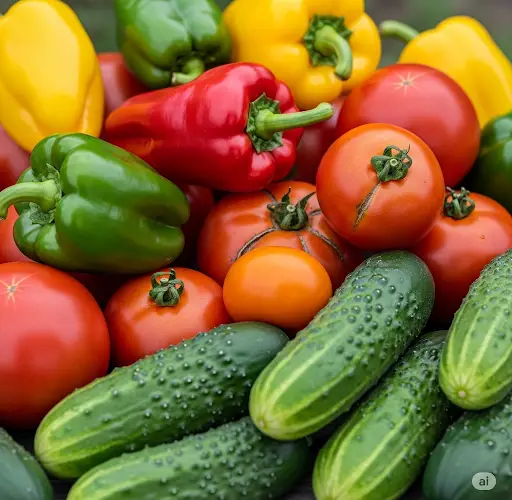For gardeners looking to boost their vegetable yields, timing and technique matter — especially when it comes to watering and feeding young plants. One simple step, applied at the seedling stage, can dramatically increase plant vigor and lead to an early and abundant harvest of tomatoes, peppers, and cucumbers.
Whether you’re growing your vegetables in the garden, greenhouse, or containers, properly caring for your seedlings sets the foundation for a successful growing season. Here’s how a specific watering and feeding strategy can help your plants thrive and produce ahead of schedule.
The Power of Early Feeding and Deep Watering
Seedlings are fragile in appearance, but they have strong potential when supported with the right nutrients and moisture. Many gardeners notice their crops flourish when they provide a thorough watering combined with a nutrient-rich feeding early in the growth phase.
This early boost energizes the root system, supports rapid leaf development, and encourages early flowering — leading to earlier fruit formation and ultimately, a richer harvest.
Tomatoes, peppers, and cucumbers all benefit from this approach. Though their needs vary slightly, they share one key requirement at this stage: consistent, well-balanced hydration and nutrition delivered at the root zone.
What to Water With
Plain water is essential — but when paired with a carefully selected nutrient mixture, the results are remarkable.
Here are several natural feeding options that can be added to your watering routine:
1. Compost Tea
Made by steeping mature compost in water for 24–48 hours, compost tea is rich in beneficial microbes and nutrients. It strengthens seedlings, boosts immunity, and supports soil health.
2. Yeast Solution
A simple mix of baker’s yeast, sugar, and warm water kick-starts microbial activity in the soil, helping roots absorb nutrients more efficiently. This method is especially helpful for tomatoes and cucumbers.
3. Wood Ash Water (for Potassium)
A tablespoon of clean wood ash dissolved in a liter of water creates a mild potassium solution ideal for early flowering and fruit development, especially in peppers.
4. Diluted Milk or Whey
Adding calcium through diluted milk (1:10 ratio with water) strengthens cell walls and helps prevent blossom end rot in tomatoes and peppers.
5. Banana Peel Soak
Soaking banana peels in water for a day or two creates a potassium-rich solution that encourages early bud formation in fruiting vegetables.
Whichever solution you choose, be sure it’s well-diluted and applied in moderation — seedlings are delicate and can be damaged by overly strong mixtures.
How and When to Apply
Apply your chosen liquid feed directly to the soil around each seedling — not on the leaves — to ensure nutrients go straight to the roots. Here’s a simple plan:
-
Volume: Use about 100–150 ml per seedling.
-
Timing: Apply in the early morning or late afternoon to avoid evaporation and stress.
-
Frequency: One feeding every 10–14 days is sufficient at this stage.
Make sure the soil is already moist before applying any nutrient solution to prevent root shock. Avoid feeding dry soil with concentrated mixtures.
Why This Method Works
This type of early intervention sets plants on a path of strong development. When seedlings receive optimal nutrition from the beginning:
-
Roots develop faster and deeper.
-
Plants grow stronger stems and more leaves.
-
Buds form earlier, leading to early flowering.
-
The likelihood of transplant shock is reduced.
-
Plants resist diseases and pests more effectively.
All of this adds up to an earlier and more abundant harvest, especially valuable in regions with short growing seasons or for gardeners aiming for high productivity from limited space.
Supporting Conditions for Maximum Results
Feeding alone isn’t enough — plants also need the right conditions to respond well to your care:
-
Sunlight: Ensure 6–8 hours of sunlight daily, or use grow lights indoors.
-
Air circulation: Avoid overcrowding seedlings; good airflow prevents fungal issues.
-
Temperature: Keep seedlings warm (18–24°C or 65–75°F) for optimal growth.
-
Hardening off: Gradually introduce indoor-grown seedlings to outdoor conditions before transplanting.
Final Thoughts
Sometimes, the simplest changes in gardening routines lead to the most impressive results. By taking the time to deeply water and feed your tomato, pepper, and cucumber seedlings early in their life cycle, you’ll set them up for a strong start — and they’ll reward you with vigorous growth, early fruiting, and a generous harvest.
Whether you’re a beginner or an experienced gardener, this method is easy to apply and incredibly effective. With just a little extra attention in the seedling stage, your garden can overflow with ripe tomatoes, crunchy cucumbers, and vibrant peppers — weeks ahead of schedule.



